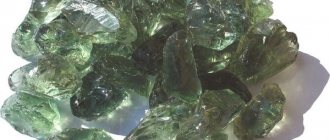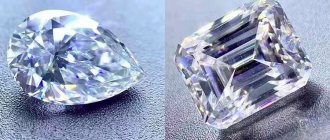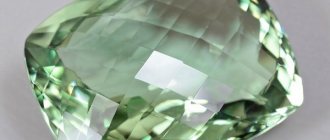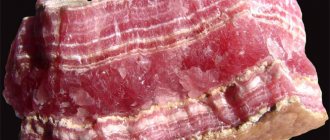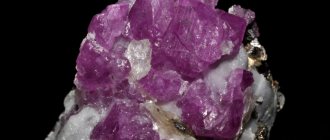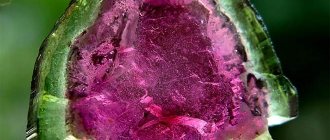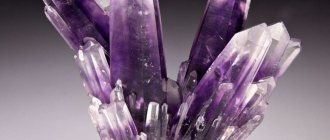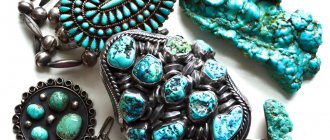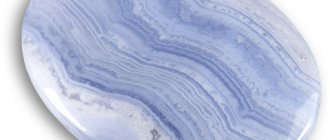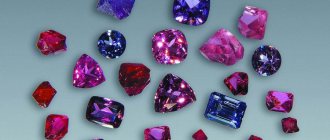| Category | Silicate minerals |
| Title in English | Actinolite |
| Formula | Ca2(Mg,Fe)5(OH)2 |
| Group | Group of amphiboles of the silicate class |
| Color | Green, Black |
| Stroke color | White |
| Shine | Glass |
| Transparency | Translucent, Transparent |
| singonia | Monoclinic |
| Hardness | 5,5 — 6 |
| Cleavage | Perfect |
| Density, g/cm³ | 2.9 - 3.3 g/cm³ |
| Kink | Splintered, Stepped |
| origin of name | If you hold actinolite under sunlight, you can see the beautiful shimmer of all its facets. For this feature, the stone received a name that combines the Greek words aktinos - ray and lithos - stone. The official name was given to the gem in 1974. |
| Morphology | The structure of the stone is in the form of elongated plate-like crystals, reaching a length of up to 15 cm. The crystals can be curved. They range from radial fibrous to asbestos-like and from granular to massive. |
The mineral actinolite is a silicate containing iron. It is painted in gray-brown-green colors and consists of a large number of needle crystals, which give the stone radiance and shine, which is why it got its name “radiant”. Along with actinolite, garnet, quartz, talc, and epidote are often mined. This gem is used in jewelry, and its elastic variety is used to make rubber for tires.
Actinolite deposits
Actinolite is a common mineral, deposits of which are not uncommon.
Its most significant deposits were found in Russia (Urals, Karelia, Primorsky Krai, Yekaterinburg), as well as in countries such as Austria, the USA, Brazil, China, Canada and New Zealand. — Advertising —
Transparent actinolite is mined in Africa, and deposits of blue-gray stone are located in Italy. High quality crystals for making jewelry come from Tanzania and the northern regions of India. Instances of ornamental quality were found on the territory of Ukraine in the Azov region.
Switzerland, Slovakia, Afghanistan and Madagascar also began to develop actinolite deposits.
Physical research methods
Differential thermal analysis
The DTA curve is similar to the curve for tremolite, but dehydration and decomposition of the actinolite structure, as well as melting of its decomposition products, occur at slightly lower temperatures; Along with pyroxene and cristobalite, iron oxides are present in the decomposition products. Additional endothermic effects on the DTA curves of actinolite may be due to impurities of calcite (750–800°), clinohumite (500–600°), and epidote (970–1000°). When actinolite is heated in an air atmosphere from approximately 400°, oxidation of divalent iron occurs. The oxidation of iron is possibly accompanied by the separation of protons from hydroxyl groups. With intense oxidation, the weight loss upon heating is less than the water content in the mineral. Iron oxidation and partial dehydroxylation cause changes in the optical properties of actinolite. In the range of 400–600°, browning begins and a slow increase in refractive indices occurs; at 600–800°, the color becomes red-brown, refractive indices increase sharply, especially in samples with a high Fe2+ content (by 0.100 or more), the cNg angle decreases to 10 ° (sometimes up to 2-5 °), the 2V value drops slightly.
Ancient methods. It melts with difficulty under a blowpipe and produces grayish-green or greenish-black glass.
History of actinolite
Actinolite has been known since ancient times, but was described and given its name in 1794.
The Greek words "actinos" and "lithos" are translated as "ray" and "stone", that is, the literal translation of the name of the mineral is radiant stone, which indicates shiny, shining crystals made in the form of rays. After some time, various types of actinolite were discovered and described, each of which received a separate name.
Crystal optical properties in thin preparations (sections)
In thin sections in transmitted light it is weakly colored, pleochroism according to Ng is light green, grayish-green, rarely dark green, according to Nm it is pale green or yellowish-green, according to Np it is colorless or yellowish, sometimes pinkish. Brown tones of pleochroism are not typical. Sometimes there is uneven coloring of individuals. Biaxial (—), very rarely (+). The plane of the optical axes (010). In some actinolite asbestos, due to the deformation of the fibers, the extinction is direct. Elongation (+) ng = 1.640 - 1.665, nm = 1.625 - 1.650, np = 1.615 - 1.643, ng - np = 0.017 - 0.028. 2V = 70 - 84°, up to 87 and 90°18′ with low Ca content. 2V = 40 - 50° was noted for asbestos varieties. Sometimes weak dispersion r < v. Twinning. according to (100) simple and polysynthetic, twins according to (010) are indicated. Sometimes, under a microscope, lamellar cummingtonite inclusions oriented along (100) and (101) are detected; they partially experienced collective recrystallization. In actinolite from the Ruby Mountains (USA), the thickness of lamellar cummingtonite inclusions is up to 50 µm; their number is 45% by volume. When actinolite is incompletely replaced by common hornblende, intergrowths with a common axis b are formed; the boundaries between individuals are uneven but clear. The manganese actinolite contained orthite inclusions surrounded by pleochroic courtyards.
Physico-chemical characteristics of actinolite
— Advertising —
Iron and silicon are the predominant elements in the composition of actinolite; depending on their percentage content, the color of the mineral changes. Impurities include compounds of titanium, aluminum, potassium, manganese and magnesium.
The crystals have a monoclinic system, the shape is needle-shaped or columnar, elongated. The color range ranges from green, greenish-gray to black. The stone is transparent or translucent. It has a glassy, pronounced shine. In some specimens there is a “cat’s eye” effect due to the shine of thread-like thin fibers.
At the fracture, the actinolite is uneven. It has medium cleavage, hardness 5-6. The density is 3.03-3.24 g/cm3. This mineral is quite fragile, but resistant to acids, slightly soluble only in hydrochloric acid.
Chemical and physical characteristics
According to the chemical classification, the mineral actinolite is a complex silicate, the composition of which is reflected in a long formula.
| Formula | Ca2(Mg,Fe)5[Si8O22](OH)2 |
| Color | Grayish green to dark green |
| Stroke color | White |
| Shine | Glass or silky |
| Transparency | Translucent |
| Hardness | 5,5 — 6 |
| Cleavage | Perfect |
| Density | 2.9 - 3.3 g/cm³ |
| singonia | Monoclinic |
In addition to the basic elements - silicon and iron, there are admixtures of aluminum, manganese, magnesium, and titanium.
Types of actinolite
The following subspecies of actinolite are distinguished according to their color:
- Jade - in addition to iron, contains chromium and manganese, due to which it is characterized by the widest palette of colors: from almost white through yellowish-green, grass, emerald, swamp green to black. Blue and red varieties are rare and most valuable.
- Bissolite is a fine-fiber mineral of greenish or green-gray color, deposits of which are located in the Alps. It got its name because of its external resemblance to flax fibers.
- Smaragdite is a rare bright specimen, the rich color of young grasses.
- Amianth is an actinolite of violet tones without dark spots.
Artificial production of mineral
Actinolite was synthesized under hydrothermal conditions at PH2O = 1000 bar and Pco2 = 50 bar from a mixture of CaCO3, MgC2O4-2H2O, FeC2O4-2H2O and SiO2 gel. Complete isomorphic miscibility of tremolite and ferroactinolite has been established. The lower temperature limit of stability decreases from 500° for tremolite to 375° for a pseudoeutectic composition with 75% ferroactinolite. The mineral was also synthesized in the presence of Ca and Mg chlorides. Obtained in the system CaO-MgO-FeO-Al2O3-SiO2-H2O at 150-500° and 1-8 kbar.
Diagnostic signs
Diagnostics. Easily recognized by its needle-shaped crystals and radiant aggregates, green color, strong glass luster, perfect cleavage and fragility. It differs from pyroxenes in its cleavage angle of 124 and 56 degrees.
Associated minerals. Albite, epidote, chlorite, talc, glaucophane, crossite, sericite, garnet, quartz, calcite, stilpnomelane, pumpellyite, lawsonite, titanite, rutile, leucoxene, hematite, magnetite.
The magical properties of actinolite
In ancient times, actinolite was often used by enlightened magicians, shamans and sorcerers for rituals and ceremonies, and each nation associated its own signs and legends with this gem.
On the African continent, actinolite was used to identify liars, because they believed that a change in aurora indicated who was deceiving. The stone was used in justice: if it faded in the hands of the accused, it was believed that this indicated deception and the person was found guilty.
The Chinese believed that the discovery of an actinolite crystal was a very bad omen, and it was considered even more unfavorable to bring the mineral into your home. They believed that actinolite took on the fate and energy of its former owner. Thus, picking up a mineral along the way, along with it, a person also took the fate of its owner.
At the same time, the inhabitants of the Urals, where large deposits of actinolite are located, endowed the stone with a number of opposite properties. So, they believed that actinolite brings treasures, good luck, and the fulfillment of cherished desires.
Today, actinolite is considered a symbol of ambition, decency, wisdom, courage, and loyalty. It is believed that the mineral contained in the talisman is the key to positive changes in the life of the owner.
How to care
Actinolite is fragile, medium hard, and afraid of water. Even samples need to be taken care of, taking into account these properties of actinolite:
- Select a separate spacious box for storing jewelry. For samples - a box of suitable dimensions.
- Protect from falls, impacts, compression.
- Remove dust with a dry soft cloth.
The asbestos variety of the mineral requires special treatment. In a humid environment, when interacting with water, actinolite crystals stick together. It is not advisable to even touch fibrous samples: they may crumble.
The mineral is indifferent to heat and most acids.
The healing properties of actinolite
The main use of actinolite is related to the treatment of skin diseases.
To do this, combine the mineral with silver, since its properties increase significantly. When the skin peels, wear a ring with actinolite on the right hand. Paired bracelets worn on both hands help to cope with ringworm, skin fungus and eczema. For problems with the scalp and hair, wear silver earrings with this gem. In general, actinolite has a positive effect on the entire body.
Thus, it improves the functioning of the cardiovascular system, respiratory system, digestion, bones and joints. In folk medicine it is used to restore potency. Actinolite crystals of a green hue are indicated for the treatment of mental problems.
Varieties and colors
The characteristic color of the mineral is green, sometimes with a gray or bluish tint. The shine is strong, closer to glass, the structure is translucent to transparent.
According to structure and shades, stone is divided into:
- Smaragdite is a transparent stone of emerald green color, very similar in appearance to emerald, and sometimes has a “cat’s eye” iridescence. Found mainly in ultramafic rocks. The largest deposits are Germany, Austria and the Swiss Alps.
Smaragdite - Jade has been known for thousands of years; this stone is especially revered by the Chinese. The ancients believed that white jade has a special energy that protects a person from negativity and dark forces, increases life expectancy and preserves peace and tranquility in the family. Dishes and figurines were made from it; palaces, tombs, etc. were decorated with it. Interestingly, women were strictly forbidden to wear jade jewelry, since it was considered exclusively royal. Jade deposits are the USA, Canada, China, Kyrgyzstan, Italy, Germany, Poland.
Nephritis - Amyanthus - found in its pure form, mainly has a purple tint without dark impurities.
Amyant - Bissolite has a fine structure and a bright green color, reminiscent of the first greenery of spring. It is found only in the Alps and is a rare actinolite.
Bissolit
Based on its composition, actinolite is divided into:
- Manganese - was first discovered in a manganese deposit in Japan. The most beautiful specimens are considered to be dark green in color with irregularly folded gray-brown veins. With a lower manganese content, the mineral will be similar to brown garnet and have colorless crystals.
- Asbestos is a parallel fibrous stone with a high iron content. In addition, it contains asbestos, which appears as veins on the mineral. Externally, the stone resembles shaggy grass; some specimens have a “cat’s eye” effect. Asbestos actinolite is very fragile, its fibers can disintegrate from a light touch to the stone, and upon contact with water, its crystals begin to stick together. At the same time, it is used in the production of acid-resistant materials. The mineral is found in cracks in volcanic rocks; its deposits are the Urals, Northern Kazakhstan, Northern Caucasus, Mongolia and Tuva.
- Bissolite, or actinolite zillerite, is formed during hydrothermal alterations of the main rocks of crystalline schists. Deposits - Canada, Switzerland, Bulgaria, Algeria, Uzbekistan and the Northern Urals (subpolar region).
Branches of application of actinolite
Actinolite is not only unusual and beautiful, but also quite easy to process, which has made it a popular stone in jewelry.
The transparent mineral is used to create jewelry - earrings, rings, brooches, pendants and necklaces. Opaque crystals are used to make bracelets, beads and necklaces. Beads and small beads for embroidery are also made from actinolite, and large specimens become the basis for beautiful souvenir balls.
Stones of unusual shapes and intergrowths are collected by collectors.
Elastic samples with a fine-fiber structure are used as rubber fillers.
Where is it used?
Actinolite has found application in serious industries and the sphere of beauty.
The asbestos variety of stone is used in the production of acid-resistant materials and refractories.
The stone is classified as semi-precious or semi-precious, difficult to process, but looks unique and is affordable. It is taken away by hand-made masters. Transparent crystals are used on earrings, pendants, and rings. The most expensive frame is silver. The rest become beads for necklaces, bracelets, and pendants.
Actinolite cabochon (Ural) 52-56 mm
Collectors strive to obtain pure actinolite (especially “maned” asbestos) and samples intergrown with other minerals.
How to distinguish real actinolite from a fake
To determine the naturalness of actinolite, do the following:
- The sample is held in a candle flame, but the real stone does not melt:
- A piece of mineral is dipped into acid. Natural stone does not change its structure and color.
Form of being in nature
The appearance of crystals . The crystals are mostly long-prismatic, axially elongated, parallel-columnar to needle-shaped and fibrous, less often short-prismatic or wide-tabular; finite edges are rare. Skeletal forms were noted. Vertical hatching is common on the m(110) faces; formed by a repeating combination of shapes (110) and (110).
Twins according to (101) are common and polysynthetic.
Aggregates. Crystals up to 20 cm in length, granular masses, pseudoms phoses and rims around grains of hornblende and pyroxene, porphyroblastic discharge, columnar, sheaf-shaped radial aggregates, transverse and longitudinal fibrous veins (asbestos), cotton wool-like clusters of fine needle crystals (bissolite) , dense masses (jade).
Actinolite and zodiac sign
Actinolites are suitable for all zodiac signs, but most of all – Sagittarius and Aquarius. In order for the talisman to bring success, it is important to buy it yourself and not give it to anyone, since this stone interacts very closely with its owner and is capable of taking away good energy when sold or even temporarily stored from another person.
Chemical composition
The composition of tremolite, taking into account isomorphic substitutions, is expressed by the formula (Na, K) -o.5(Ca 2-1.34 Na0-0.66) [(Mg, Mn, Al)5-4 (Fe2+, Fe3+ )0-1] [(Si8-7.5 Al0-o.5) (O, OH)22] (JH, F, Cl, O)2. Theoretical composition for the formula Ca2Mg8Si8O22(OH)2: CaO - 13.80, MgO - 24.81, SiO2 - 59.17, H2O - 2.22. The CaO content is usually in the range of 12-14%; in tremolites from carbonate rocks no less than 13%, in some tremolites from ultramafic rocks up to 10.5%. The amount of MgO is usually 20-25%; in tremolites from carbonate rocks 24-25%, in tremolites from ultramafic rocks 21-23%. FeO content up to 7%, Fe2O3 up to 3.75% (usually much lower). The lowest Fe content is in tremolites from marble (up to hundredths of a percent). Tremolites from ultramafic rocks contain 1.5–4.5% FeO and can be considered transitional to actinolites. MnO is almost always present, up to 0.6% (Mn 0.06-0.07). An increased amount of MnO (up to 1.5%) was noted in tremolite (“hexagonite”) from Gouverneur, pcs. New York, USA). The amphibole from Longbahn, Sweden, transitional from tremolite to richterite, contains up to 5.81% MnO, and the manganese-zinc tremolite from Franklin contains up to 5.4% MnO (MnO0.9). An unusually high (8.97%) MnO content was noted in fibrous tremolite from the Dzhumart iron-manganese deposit, Kazakhstan, but the purity of this material requires confirmation. A small amount of alkali metals is almost always present: Na2O up to 0.75% (Na 0.20), K2O up to 0.35% (K0.06). There are tremolites with a high content of alkalis (Na2O up to 2% and K2O up to 0.70%). This variety of tremolite is intermediate in composition between the two theoretical end members, tremolite and edenite. Tremolites, transitional to calcium-sodium amphibole - richterite, were also noted; they contain up to 2.3-3.7% Na2O. Tremolites from ultramafic rocks often contain Cr2O3 (up to 0.65%). An unusually high Cr2O3 content (2.97%) is found in a mineral from the Zoritag chromite deposit in Turkey, described as “chrorn-tremolite”; however, the data from his analysis require clarification. In addition to Cr2O3, up to 0.33% NiO and up to 0.11% CoO are found in individual tremolites from ultramafic rocks. The Al2O3 content is 0.15–3.00%; SiO2—54–59%, rarely less (in tremolites from carbonate rocks it is mainly 57–59%, from ultramafic rocks sometimes up to 57% and lower). The TiO2 content usually does not exceed hundredths of a percent. Tremolites from carbonate rocks often contain F, the highest content (up to 1.5%) was noted in tremolite from Gouverneur in the USA and in tremolite from Kaveltorp, Sweden (0.94-1.15%). The total amount of OH- and F- in tremolites from carbonate rocks is about 2 or less per formula unit, and no replacement of oxygen by OH groups has been noted. Tremolites from ultramafic rocks contain no more than 0.20% F. The H2O+ content reaches 3%. Cl was found in tremolite from iron ore metasomatites.
Varieties
Tremolite radiant aggregates North Caucasus
Composition:
manganese-zinc tremolite - manganese-zinc tremolite - found in the Franklin deposit, pcs. New Jersey (USA) along with other minerals containing Mn and Zn. In addition to the unusually high content of ZnO (up to 9.5%) and MnO (5.4%), a low content of CaO and an increased content of water is characteristic. Forms coarse-grained masses with calcite and minor admixtures of sphalerite and willemite, or is associated with franklinite, calcite and Mn-andradite. It differs from ordinary tremolite in having higher refractive indices and higher density.
By the nature of the release:
Nephritis
— nephrite is a dense microfibrous variety of tremolite.
Tremolite-asbestos - tremolite-asbestos - parallel-fibrous tremolite. The name asbestos comes from the Greek “asbestos” - insoluble (Plinius, 1851-1858). Synonym: Amianth - amianth, amiant (Plinius, 1851-1858); amiantinite—amiantinite (Allan, 1819); amianthoide—amianthoide (Delametri, 1797); amianthus - amianthus (Agricola, 1546); asbestinite - asbestinite (Chester, 1896); asbestoid - asbestoide (Vokalin, Makvart, 1797); asbestus - asbestus (Agricola, 1546); mountain flax - Bergflachs, mountain wool - Berg-wolle, mountain wood, mountain hair - Berghaar (Emering, 1793); caristine—carystine (Hil, 1771); kymatine (Breithaupt, 1830). The listed old names were also used to designate actinolite- and ferroactinolite-asbestos and partly other fibrous silicates. Abkhazite—abkhazite, abchasite (Efremov, 1938)—asbestos-like amphibole with a high content of CaO (16%) from Abkhazia. Bedenite - bedenite (Serdyuchenko, Efremov, 1936) - asbestos with direct extinction from Mount Beden, North Caucasus. The fibers are somewhat coarser than those of alkali amphibole asbestos, are more difficult to split, are more fragile and have relatively low strength. Fiber length up to 0.5 m; Varieties suitable for spinning are rare. The quality of asbestos depends on the amount of impurities and the degree of perfection of fiber orientation. In high-grade asbestos they are oriented parallel to the c axis and rotated relative to each other at arbitrary angles; the Lauegram of such a beam is similar to the X-ray pattern of rotation of a single crystal. Under a microscope, it differs from other asbestos in oblique extinction, weak pleochroism, and high birefringence; sometimes the extinction is direct. A possible reason for the change in optical properties is tectonic influences (torsion and sliding). There are few chemical analyzes of pure tremolite asbestos. Thin films of calcite, magnetite and other minerals are common on the fibers. Calcite impurities are sometimes difficult to remove even when boiled in HCl. Tremolite-asbestos has high acid and alkali resistance (only slightly inferior to anthophyllite-asbestos). Adsorbs moisture much weaker than chrysotile asbestos; almost does not adsorb alkali. With a high content of Na2O it has filtering properties. Various hypotheses have been expressed about the reasons for the appearance of a parallel-fibrous structure: formation from a gel during its dehydration under tensile conditions; crystallization from solutions filling cracks; recrystallization; replacement during directed dissolution of rocks along the walls of cracks or along a pore system. Tremolite asbestos, more than alkaline asbestos, is characterized by a longitudinal and oblique fiber structure of veins and veins. Probably, such aggregates formed in cracks along which sliding movements occurred during asbestos formation. It has been experimentally proven that the formation of fibrous tremolite occurs at temperatures of 400-500° (in the low-temperature part of the tremolite stability field), especially in the presence of alkali metals in the solution. With increasing pressure, the temperature of formation of fibrous tremolite increases to 500-550°. Tremolite-asbestos deposits are confined to carbonate and serpentinized ultrabasic rocks. Asbestos deposits in marbleized and dolomitized limestones occurring among quartz-sericite-chlorite schists are known in the Polar Urals in the area of the Vangyr and Patoka rivers. The largest veins (thickness up to 40 cm and length 10 m) are confined to cracks along the bedding; asbestos is accompanied by columnar calcite, dolomite, aragonite, and sometimes contains inclusions of quartz, magnetite and hematite. In some veins along the strike, tremolite-asbestos is replaced by chrysotile-asbestos.
Deposits of tremolite-asbestos in serpentinized ultramafic rocks are often located near granite intrusions, in contact zones of veins of acidic, less often basic rocks, in places without signs of connection with later intrusive activity. Asbestos in the form of vein-like bodies of a transverse, oblique and longitudinal fibrous structure is associated with chrysotile, antigorite, talc, calcite, breunerite, dolomite, chlorite, hydrobiotite, magnetite. The length of the veins reaches tens of meters; clusters of small subparallel veins forming lens-shaped deposits are more common. The host rocks are characterized by intense talcification and carbonatization. Deposits of this type are found in the Italian Alps (La Balma, Di Punta Lunella and others), in Switzerland, Austria, the Czech Republic, Scotland, Chile, Australia and other countries. In Russia, tremolite-asbestos in serpentinites is observed in the Southern Urals, the Northern Caucasus, and the Kola Peninsula. The replacement of tremolite-asbestos with chrysotile-asbestos and talc has been established. In the weathering crust, its fibers become brittle or loose. It was noted that tremolite-asbestos was replaced by an aggregate of calcite and brucite with preservation of the fibrous structure [110]. Used in the manufacture of insulating materials, as an acid-resistant material; a natural mixture with talc (asbestos) is used as a filler in the manufacture of plastics.
Tremolite-byssolite - tangled fibrous tremolite. The name byssolit comes from the Greek “byssos” - flax; “cast” - stone (Saussure, 1796). Synonym: Tremolitic zillerite. Observed in the form of bundles of fibers and light cotton wool-like aggregates. Individual fibers are fine-needle crystals with crystal-graphic outlines and polygonal sections, the diameter of which is thousandths of a millimeter. The fibers are coarser than asbestos and have a uniform thickness along their entire length. Characterized by straightness and lack of interweaving. The fibers are fragile and little flexible, do not split, and when abraded they produce sharp fragments. Color ranges from pure white and light gray to dark grass green. Under a microscope, it differs from other entangled fibrous minerals in its oblique extinction, light tones of pleochroism, and high birefringence. A lack of cations in octahedral positions and an excess of water are common. Tremolite-bissolite is formed in cracks and voids of crystalline limestones, serpentinites, diopside rocks and basic shales with traces of tectonic influences and circulation of hydrothermal solutions. Known in a number of places in Western Europe; Douce Geo (Scotland); Aiguille de Goute, Corsica (France); Sahlberg (Sweden); Schwarzberg in Saxony (Germany); Zermatt and Campo Longo (Switzerland); Pregratten and Zillertal in Tyrol and Fölling in Lower Austria (Austria); Mezieors (Hungary); Sasca, Dognecea (Romania). In Russia, tremolite-bissolite was found in calcite-dolomite-tremolite metasomatic rocks of the Lesnaya Baraka massif, Kola Peninsula, in calcified serpentinite of the Tkhach River region in the North Caucasus, in cracks and cavities in the endocontact zone of granite intrusion with serpentinite xenoliths in the Beskes River basin ( Northern Caucasus), where crystals of pyrite, calcite and brucite grow on tremolite-bissolite fibers. Replaced by talc and serpentinite while maintaining the fibrous structure.
Has no practical application.
Interesting facts about actinolite:
- Talismans with actinolite are recommended for anyone involved in scientific research, as well as students. It is believed that the stone becomes an assistant for making the right decisions and setting goals. In addition, jewelry with actinolite helps to change the path of life in a positive way.
- Unlike many other stones, actinolite is universal for all zodiac signs. But this mineral should have only one owner. The gem is not recommended to be given or given away to anyone, as it remains connected to its owner and contains his destiny.
Jewelry with mineral
Transparent crystals are used in the manufacture of high-quality and expensive jewelry - pendants, rings, rings, brooches and earrings. Dull specimens are used to decorate bracelets and beads.
Necklace
Stone cost
The price of a raw stone ranges from 20 to 70 dollars, while cut minerals are much more expensive - the price of some specimens can reach up to 400 dollars.
However, prices for actinolite mined as an ornamental stone are much lower, since the scale of its production is larger.
Caring for your jewelry
Jewelry with actinolite should be treated very carefully, since the mineral is very sensitive to compression and shock, especially its transparent specimens.
Such decorations must be stored in individual fabric bags to avoid contact with surrounding surfaces and other decorations.
Reference! Actinolite is not sensitive to heat, so it is absolutely not afraid of exposure to high temperatures.
How to wear
In order for the mineral to maximize all its magical properties, an amulet or talisman with it should be worn so that the stone is constantly in contact with the skin.
Ring
For medicinal purposes, jewelry with actinolite is worn either on one or simultaneously on both hands, as well as on the head (earrings) and on the chest (pendants, brooches). It is advisable that the jewelry be made of silver - this noble metal enhances the healing properties of the mineral.
How to distinguish from a fake
As noted above, the mineral is not sensitive to high temperatures and acids, so its authenticity can be verified with fire or acid. The fake stone will begin to melt, while the original will remain unchanged.
Healing qualities
The therapeutic effects of the gem are aimed at eliminating various types of skin problems.
The magic crystal is used to cure serious dermatological diseases: fungal diseases, various types of lichen, eczema, rashes. It is necessary to wear the mineral in the form of jewelry set in silver, since such metal can enhance the healing effect of actinolite. The stone improves the activity of the heart and blood vessels, improves the functioning of the respiratory organs and intestinal tract; the gem can heal joints and problems with the spine. Traditional medicine doctors claim that it is suitable for representatives of the stronger sex who are looking for a solution to their own difficulties with potency.
Actinolite of emerald tone is used to cure disorders of the nervous system, in addition to recovering from a prolonged state of apathy.
Origin and location
Tremolite is widely distributed in metamorphic and metasomatic rocks formed at the expense of carbonate and ultramafic rocks, often under the influence of post-magmatic hydrothermal solutions along fracture zones and at contacts of rocks of different chemical compositions. In dolomite and calcite marbles and calciphyres, it forms scattered inclusions, porphyroblastic and lens-shaped deposits and veins, in which it sometimes has an asbestos-like composition. Often confined to contact with quartz veins or interlayers of quartz-sericite, chlorite-sericite and other schists, it composes monomineral tremolithites. Tremolite in carbonate rocks is characterized by association with diopside and talc. Tremolite is often associated with skarn and ore minerals. Tremolites formed in carbonate rocks are the least ferrous and contain a lot of fluorine, calcium, magnesium, and silicon.

